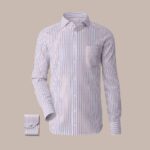Shirts are versatile articles of clothing; they dress us up, hint at our personalities, and can make a bold statement or fade into the background with subtle elegance. Yet, many of us must consider the intricate design details that give it its form and function before we grab a shirt off the rack. For fashion enthusiasts and clothing retailers alike, understanding the parts of a black shirt is fundamental to appreciating the nuances of style, fit, and quality. Whether you’re looking to spruce up your wardrobe or stock your shelves with the best designs, this detailed exploration of the parts of a shirt sleeve is a must-read for anyone who values sartorial sophistication.
Dissecting the Anatomy of a Shirt
Before we dress to impress, we must understand the foundation of our attire. Here’s a breakdown of the key components of a shirt, each playing a vital role in its construction and appearance.
The Collar
The focal point of a shirt’s upper half is the collar, the most significant detail that sets the tone of the entire garment. Collar styles vary widely, from the traditional pointed collars to the more modern band or mandarin collar. This part frames the face and contributes to the shirt’s formality. A pointed collar, for instance, is the default choice for business shirts, while a button-down collar adds a casual, preppy touch.
The Cuffs
Cuffs often go unnoticed but are crucial to sleeve management and outfit coordination. A shirt generally features two cuffs at the end of each sleeve, and they, too, come in various styles. French or double cuffs are a hallmark of formal dress shirts, often adorned with cufflinks for a touch of sophistication. Contrastingly, barrel cuffs are the simpler option appropriate for most casual and business-casual settings.
The Yoke
This oft-overlooked part of the shirt is the crucial bridge between the collar and the body of the garment. A well-fitted yoke goes a long way in ensuring comfort and proper shoulder line. Shirts may have a one-piece yoke or a split (bi-swing) yoke that is more ergonomic and distinctive in its design.
The Placket
Running down the center front of a shirt, the placket provides structure and is a style feature in its own right. Visible or concealed plackets are chosen based on the shirt’s aesthetics, and some designs may opt for a contrasting placket for added flair.
The Pocket
Function meets fashion with the inclusion of a pocket on shirts. While not always present, a well-placed pocket adds utility and can serve as a design element, especially when it features a unique shape or flap design.
The Pleat
Pleats, when present, are found on the back of the shirt and allow for more movement and comfort. Box pleats provide a structured look, while side pleats offer more room and drape.
Function Meets Fashion
Every part of the shirt plays a role in its performance as a daily wear item or as an element of personal style. Understanding the importance of each element can help you make informed decisions about your shirt collection.
Why the Collar Matters
The collar is the most visible part of a shirt in a business or formal setting. It complements the wearer’s stature and dictates the tie’s knot style and formality. Understanding various collar designs and their appropriateness for different events is key to a polished look.
The Tale of Two Cuffs
Cuffs affect the shirt’s aesthetic and how it is worn. Barrel cuffs, the more common option, wrap neatly around the wrist, offering a clean, classic look. In contrast, French cuffs exude elegance when paired with tailored attire, and the choice of cufflinks introduces a layer of personal style.
Yoke Placement and Shoulder Line
A misaligned yoke can throw off a shirt’s entire fit. Ensuring the right yoke fit guarantees that the shoulder seams sit at the correct place along the shoulder blade, enhancing comfort and aesthetics.
Pocket or No Pocket?
Pockets on shirts are often a point of contention. While some purists believe that pockets mar the formal look of the garment, others appreciate their functionality. The choice of a pocket should align with its use’s overall style and context.
Selecting a High-Quality Dress Shirt
Not all shirts are created equal. Quality construction not only ensures the garment’s longevity but also affects how it feels and wears on the body.
Inspecting the Seams
Strong, neat stitching is a sign of a well-constructed shirt. Loose seams or unraveling are a red flag for low quality. Double-stitched seams are an added reinforcement for areas prone to stress, like the shoulders or cuffs.
The Weight of the Fabric
The fabric’s weight can indicate the quality and seasonal appropriateness of the shirt. Lighter, finer weaves are often associated with dressier shirts, while heavier fabrics like Oxford cloth convey a more casual, durable feel.
Examining the Cuff and Collar Stiffeners
Higher-end shirts often have removable or permanent stiffeners in the cuffs and collar. These help maintain the shape of these parts, especially after laundering. You should be looking for a flexible and soft feel—not flimsy.
Matching Patterns Across Parts
Attention to detail shines in shirts where pattern matching is obvious. The front placket should align with the rest of the shirt design, and any patterns, particularly in the yoke and sleeves, should flow seamlessly into the main body of the garment.
Current Trends in Shirt Design
The contemporary market is bustling with innovations that blend the classic badge of the shirt with modern sensibilities. Shirts are now designed with exciting twists on their conventional parts, such as detachable collars, convertible cuffs, and invisible plackets. These features add versatility and offer a fresh perspective on traditional shirt design.
Conclusion
Knowing the parts of a shirt collar is more than just recognizing theoretical aspects of fashion; it’s a practical understanding that can elevate personal style and merchandising strategy. This comprehensive guide serves as a beacon for those seeking to appreciate every detail’s role in delivering a stylish and functional shirt. By familiarizing yourself with these components, you can better express your fashion choices and make more informed selections for your wardrobe or store. The next time you slip into a shirt, you’ll do so with a deeper understanding of the craftsmanship and artistry that went into its creation. Happy styling!
Also See>>>>> Shirtsmockup
FAQs
Why are there different collar styles, and how do I choose the right one?
The collar is a defining feature of a shirt and can significantly impact its overall look and formality. The right choice depends on the occasion and personal style preferences. For business settings, a classic point or spread collar is versatile. A button-down collar is more casual and ideal for a laid-back look. Consider the size and shape of your face and the type of tie knot you prefer when selecting a collar style.
What are the differences between French cuffs and barrel cuffs?
French cuffs (or double cuffs) fold back and are secured with cufflinks, offering a more formal appearance suitable for special occasions or business attire. Barrel cuffs wrap around the wrist and fasten with buttons, providing a practical and versatile option for everyday wear. Your choice between the two should align with the event’s formality and your style.
How important is the yoke in a shirt?
The yoke ensures a proper fit across the shoulders and back. A well-fitted yoke means the shoulder seams sit perfectly on your natural shoulder line, providing comfort and a clean, tailored appearance. Some shirts come with split yokes, which can offer more flexibility and adapt better to your body movements.
Should my shirt have a pocket?
A pocket on a shirt is largely a matter of personal preference and context. A pocket adds functionality and can contribute to a casual aesthetic. However, for very formal occasions or dress shirts meant to be worn with suits, a clean, pocket-less design might be more appropriate.
What’s the role of pleats on the back of a shirt?
Pleats on a shirt’s back provide extra fabric, allowing for a greater range of motion and comfort. Box pleats offer a more traditional look, while side or darted pleats give a shirt a fitted appearance. The choice depends on your mobility essentials & fit preferences.
How can I tell if a shirt is of high quality?
A high-quality shirt is characterized by neat, tight seams, quality fabric, and attention to detail in construction. Look for signs such as clean stitching, no loose threads, and fabric that feels comfortable and durable. High-quality shirts often have removable collar stays, mother-of-pearl buttons, and gussets for added durability.
Does the weight of the fabric matter?
Yes, fabric weight plays a significant role in the shirt’s feel, durability, and suitability for different seasons. Lighter fabrics like poplin or fine cotton are ideal for warmer months or formal occasions. At the same time, thicker materials like Oxford or Twill are better suited for casual wear and cooler temperatures.
How do I ensure the right fit?
Ensure the shoulder seams align with your natural shoulder ends. The cuffs should end just above the hand, allowing room for a watch if worn. The collar should fit snugly around your channel without being too tight. Pay attention to the shirt’s length if you intend to tuck it in.
Can I customize parts of my shirt?
Many tailors and custom shirt makers can customize various parts of your shirt, including collar style, cuffs, and adding or removing a pocket. This service allows you to create a shirt that perfectly matches your style and fit preferences.



No Comment! Be the first one.